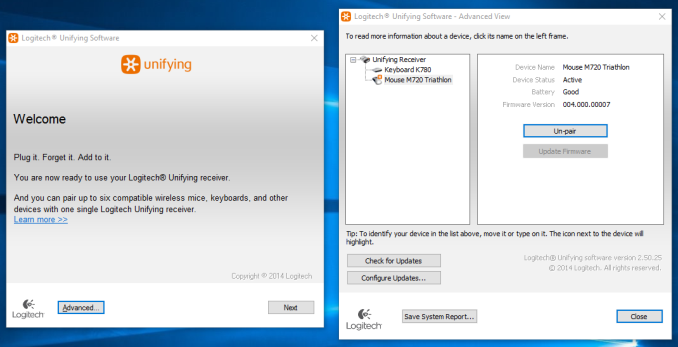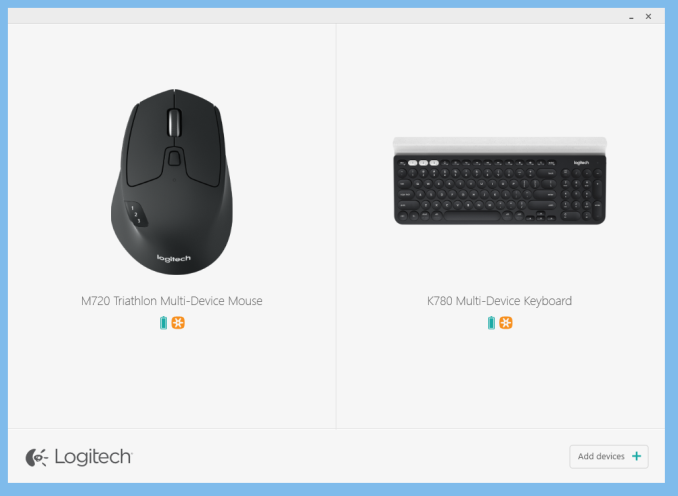Logitech Multi-Device K780 Keyboard and M720 Triathlon Mouse Review
by Ganesh T S on September 14, 2016 3:01 AM EST
Logitech introduced an innovative multi-device Bluetooth keyboard, the Multi-Device K480, back in 2014. The K480 could be configured for use with up to three different devices, and definitely stood out in the crowded I/O peripherals market. Our wish-list for a follow-up product included an integrated trackball or touchpad and ability to use such multi-device peripherals with a wider range of PCs (not just the ones with Bluetooth capabilities).
This year, Logitech has expanded their multi-device lineup with two new products:
Both products retain the important characteristics of the K480. They can be paired with up to three different host devices and easily switch between them. The hosts can be Android, iOS, Mac or Windows devices, and the keys in the keyboard get automatically re-mapped depending on the host OS. Similar to the K480, the K780 has Mac / iOS inputs printed in grey on the keyboard. Both the mouse and the keyboard have explicit on/off buttons in order to conserve battery life.
The two products together address many of the shortcomings of the K480 from 2014. The important features / changes are summarized in the list below.
- Consumers can use either Bluetooth or a 2.4GHz RF Unifying Receiver (included with both products) to communicate with the host device
- A dedicated number pad is present in the K780 (96 keys), but, not in the K480 (79 keys)
- The device-change mechanism for the keyboard has been altered. Instead of a rotary dial (used in the K480), the K780 uses multiplexed function keys for the same purpose
- The wider K780 keyboard allows for compatibility with more devices (including the iPad Pro in portrait mode) when it comes to placement in the cradle at the top of the unit. The K780 is also heavier and more sturdy compared to the K480.
- The keys in the K780 are easier to type on and provide a better usage experience compared to the ones in the K480.
- The mouse contains buttons and gesture support that make it ideal for use with tablets as well as PCs.
The Logitech Options and Unifying Receiver Software
The addition of a USB receiver to both units indicates that Logitech is targeting the new devices towards PCs also. The K780 and M720 Triathlon are sold separately. Both of them come with their own Unifying Receivers. For use-cases that don't involve the USB receiver, both units have compartments to safely stow them away.
In our review process, we first connected the M720 Triathlon to a PC with its USB receiver. After installing the Logitech Unifying Software, we were also able to pair the K780 without using its USB receiver.
The Logitech Options software enables users to configure / alter the behavior of the configurable keys of all the attached compatible Logitech devices. The Unifying Receiver program can also be triggered from within this interface. The battery status of the devices can also be viewed through this program.
The K780 options include the ability to keep the keyboard always in the Windows layout and the option to use the F1-F12 keys as standard function keys (without using the Fn. key qualifier). The configurable keys include the Home button (F4), Right Click (F5), Back (F6) and the Search button (next to F12). They can be mapped to a variety of Windows functions / programs such as closing windows, Cortana, Calculator etc.
The M720 Triathlon is marketed as a 8-button device. Two of them (the one behind the scrollwheel that controls the rate at which it moves, and the one that switches the host device to which the mouse is paired) can't be remapped. Everything else can be configured using the Options software.
The left and right buttons can be swapped. The pointer speed can be finely adjusted and the scrollwheel direction can also be swapped. The mouse also has a gesture button below the three raised buttons on the left side. The scrollwheel can be swayed right or left for horizontal scrolling (on mobile devices, that acts similar to swiping right or left on the touchscreen). Along with the device change button, we also have the Forward and Back buttons on the left. The scrollwheel can itself act as a middle mouse button. All of these can be mapped to one of a variety of Windows actions (same as the list available for the K780).
Concluding Remarks
The Logitech K780 and M720 Triathlon are a great addition to the set of multi-device I/O peripherals from Logitech. They work as advertised, and there is really not much to complain about. As mentioned earlier, the keys of the K780 are a definite improvement over the K480. Evaluation of keyboards and mice targeted towards day-to-day / casual usage is an inherently subjective exercise. In the table below, we compare the specifications of the K780 / M720 Triathlon with some of the other keyboard / mice combos that we have evaluated with a similar approach before. Some subjective scores have also been provided.
| Keyboard Bench | ||
| Aspect | Logitech K780 and M720 | |
| Device Type | Keyboard + Optical Mouse (2-button with scrollwheel / middle button and gesture support) | Keyboard + 2-button Touchpad |
| Dimensions | (Keyboard) 14.96" x 6.22" x (0.87" to 0.32") (Mouse) 2.91" x 4.53" x 1.77" |
14.40" x 4.90" x 0.65" |
| Weight | (Keyboard) 1.93 lbs / 875 g (Mouse) 0.3125 lbs / 135 g |
1.09 lbs / 495 g |
| Power Source | (Keyboard) 2x AAA (Mouse) 1x AA |
Internal rechargeable battery |
| Communication | 2.4 GHz RF and Bluetooth 4.0 | 2.4 GHz RF |
| Power Saver | Explicit On/Off Switches on both Keyboard and Mouse | Explicit On/Off Switch |
| Keys Count | 96 (with multiplexed Internet and multimedia hot keys) | 79 + 3 volume control keys |
| Touchpad Dimensions (Diagonal) | N/A | 3.7" |
| USB Receiver Storage Compartment | Yes on both Keyboard and Mouse | No |
| Backlight | No | Yes |
| Keyboard Layout | 8/10 | 8/10 |
| Ergonomics | (Keyboard) 8/10 (Mouse)10/10 |
8/10 |
| Build Quality | (Keyboard) 9/10 (Mouse) 9/10 |
9/10 |
| MSRP (USD) | (Keyboard) $79.99 (Mouse) $69.99 |
$99.99 |
| Warranty | 1 year | 1 year |
While it is difficult to find scope for improvement in the M720 Triathlon, the K780 can be made a little more attractive with full-height arrow keys (that would go well with the PC use-case).
The K780 multi-device keyboard is priced at $79.99 and the M720 Triathlon mouse is priced at $69.99. The K480 was a Bluetooth keyboard that fulfilled a niche market need. With the new multi-device models, Logitech is hoping to service that market with products that are better suited for the allied use-cases, while retaining similar price points.


































30 Comments
View All Comments
Daniel Egger - Wednesday, September 14, 2016 - link
Err, what about the K810 introduced in 2012 or so?ganeshts - Wednesday, September 14, 2016 - link
Didn't have the cradle at the top to accommodate multiple mobile devices :) but, yes, that was one of the first multi-device peripherals from LogitechPlastic Coder - Sunday, February 19, 2017 - link
Unfortunately you're showing your age here and by that I mean lack of it. The early Logitech wireless mice, back in the mid-nineties had a rotary switch to allow you to select the receiver it was paired with. This allowed you to have multiple receivers and use one mouse.It feels like I've been waiting 20 years for them to reintroduce this feature and now they finally have.
As for quality, I have Logitech mice and keyboards going back 15 years that are still working fine.
Scootcha - Wednesday, September 14, 2016 - link
Their warranty in now down to only one 1 year? Considering the double-click issues I have had in the past that does not inspire much confidence.ddriver - Wednesday, September 14, 2016 - link
Obviously, the corporate intent behind this amazing new device is to throw it in the garbage in 12 months and buy another one.There are barely any good mice today, they are all engineered to crap out, how I miss the good old intellimouse optical - it lasted 12 years of abuse, and this was back when I was quake 3 twitch gaming, and in the end it was the cable that crapped out, it was still clicking fine. Since then I changed several premium mice, including 2 of logitech's top tier, and even thou they were all several times more expensive than the intellimouse, in terms of durability they were all GARBAGE in comparison.
Black Obsidian - Wednesday, September 14, 2016 - link
Amusingly, the only mouse I ever had fail was an Intellimouse Optical; the left-click button just gave up on life. I've been all-Logitech since then, and haven't had to replace a mouse in over five years. My two Performance MXes at home and work stubbornly refuse to die, as does the M310 that takes a lot of abuse in travel. I finally replaced one of the MXes with a G502 just for the novelty factor, and I fully expect that it will also last longer than I want or need.But anecdotes aren't data, and it would be interesting to see an actual reliability study done, to see how long (in years or millions of clicks) these things actually last, on average.
ddriver - Wednesday, September 14, 2016 - link
Logitech had warranty reduced from 3 to 2 and now to 1 year. That's not a sign of confidence.Also it depends a lot on how you use it. Luck is also a factor. The biggest problem IMO is the puny switches they use, they are too frail. They are chosen for that reason thou, as the mice I've dissected upon failure have all revealed there is plenty of room on the PCB for larger and sturdier switches. The last logitech mouse I threw away was a G9, I was able to "fix" it several times by padding the plastic nib that presses the switch, but eventually got tired of it. Took out the old intellimouse, clipped the cable where it failed, then soldered the wires directly on the board, and it sill works flawlessly, 17 years old. Its only downside is it is too light, but gluing a big ass bolt nut on the top of the upper shell fixed that :D. After spending 500$ on garbage mice in 5 years I am back to the 15$ intellimouse, and it works great.
Lolimaster - Wednesday, September 14, 2016 - link
You can buy 10-20M omron switches from chinese sites, 10 for $5-7 free shipping. Those are the things people abuse specially with all the mobas based on tons of lef/right click actions. 5 years ago, those games were scarce.ddriver - Wednesday, September 14, 2016 - link
The PCB will not survive more than one replacement. Naturally, it would be too much to expect that the switches are put in sockets for easy replacement. You are not supposed to fix it, you are supposed to buy a new mouse. They made sure you won't be able to replace the switches just as they made sure to use lousy switches in the first place. Actually, a more durable solution would be to open up the existing switch and deform the springie part slightly to have better action.Lezmaka - Wednesday, September 14, 2016 - link
Yep, that's what I did to fix the double click issue on my two MX Revolution mice, fix the switch itself. It's been a couple years but I think this is the video I watched to do it:https://www.youtube.com/watch?v=V66Cd2Y4IPs